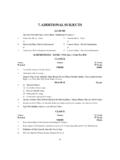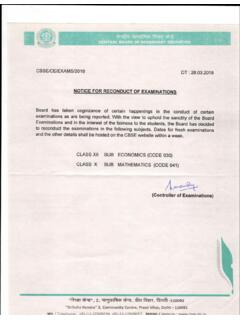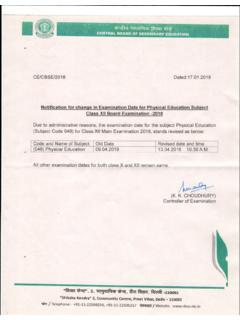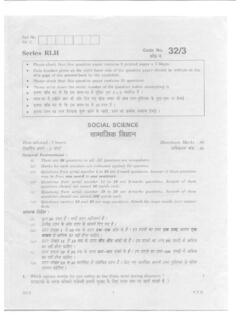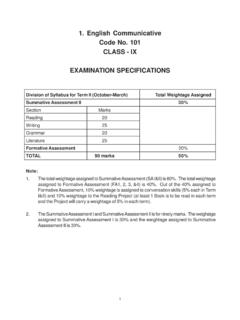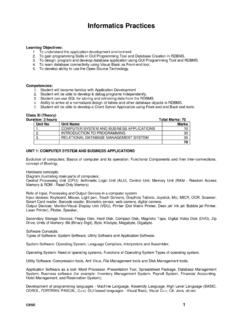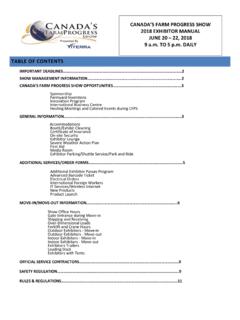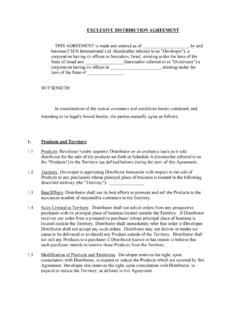Transcription of Graphic1 - CBSE
1 1 LEARNING OBJECTIVESA fter studying this chapter, you will be able:lTo understand the financial understand various alternative financial compare alternative financial instruments on key know various investment objectives and constraints of the financial understand the difference between real investments and financial had the opportunity to watch the action from the ring side seat and the thingswe saw, heard and experienced stirred some deeper thoughts in our mind about ourwisdom or lack of it, in matters related to financial markets and investors in spite of distressing evidence all around still get carried away by business is all about informed decisions. We realize that discerning data ifnot readily available in one place can make it difficult for anyone to choose an effort to capture the diverse issues of financial markets in a single summary, weshare our experiences; views and insights in this have heard about the heart rendering stories of how people were driven to destitutionwhen they lost all their money in reckless investments.
2 You may have also been captivatedby tales of how some others vaulted to indecent riches through the same process. Thischapter tries to discourage you from adopting a similar approach to investments. Instead,it suggests that an early and habitual flow of savings if invested prudently can makemillionaires out of common men. A disciplined and cautious approach to wealth managementrewards you in more ways than markets are full of imperfections, which make results inconsistent with the conditions apart, in the present world of finance, human greed, system failuresor national afflictions can make things very unpredictable. This is where risk comes intoplay. This chapter deals in sufficient details, the different manifestations of risk in eachasset class and tries to suggest you the ways to minimize of us have one simple approach to dealing with risk.
3 That is to avoid it by allmeans. In financial investment matters, this may not be a good strategy. As risk andreturn are correlated, every risk you are avoiding possibly deprives you of a handsomeopportunity to build your wealth. Balancing risk with return in line with your individualcircumstances is what financial market management is all about? This chapter throwssome light on these simple but mostly neglected aspects of managing one s own Types of MarketsEfficient transfer of resources from those having idle resources to others who have apressing need for them is achieved through financial markets. Stated formally, financialmarkets provide channels for allocation of savings to investment. These provide a varietyof assets to savers as well as various forms in which the investors can raise funds andthereby decouple the acts of saving and investment.
4 The savers and investors are constrainednot by their individual abilities, but by the economy s ability, to invest and save financial markets, thus, contribute to economic development to the extent thatthe latter depends on the rates of savings and financial markets have two major components:lMoney marketlCapital Money market refers to the market where borrowers and lenders exchange short-term funds to solve their liquidity needs. Money market instruments are generally financialclaims that have low default risk, maturities under one year and high Capital market is a market for financial investments that are direct or indirect claimsto capital. It is wider than the Securities market and embraces all forms of lending andborrowing, whether or not evidenced by the creation of a negotiable financial Capital market comprises the complex of institutions and mechanisms through whichintermediate term funds and long-term funds are pooled and made available to business,government and individuals.
5 The Capital market also encompasses the process by whichsecurities already outstanding are Securities market , however, refers to the markets for those financial instruments/claims/obligations that are commonly and readily transferable by Securities market has two interdependent and inseparable segments, the new issues(primary) market and the stock (secondary) Primary market provides the channel for sale of new securities. The issuer of securitiessells the securities in the primary market to raise funds for investment and/or to dischargesome Secondary market deals in securities previously issued. The secondary market enablesthose who hold securities to adjust their holdings in response to charges in their assessmentof risk and return. They also sell securities for cash to meet their liquidity price signals, which subsume all information about the issuer and his business includingassociated risk, generated in the secondary market , help the primary market in allocationof secondary market has further two , the spot market where securities are traded for immediate delivery and other is forward market where the securities are traded for future delivery andpayment.
6 This forward market is further divided into Futures and Options market (DerivativesMarkets).In futures market the securities are traded for conditional future delivery whereas inoption market , two types of options are traded. A put option gives right but not anobligation to the owner to sell a security to the writer of the option at a predeterminedprice before a certain date, while a call option gives right but not an obligation tothe buyer to purchase a security from the writer of the option at a particular pricebefore a certain now understand these markets in broader Equity MarketBefore discussing the equities market , we should first understand the basic meaningof markets, their functions and What is a market ?A market is a location where buyers and sellers come into contact to exchange goodsor services.
7 Markets can exist in various forms depending on various Can Markets Exist in Different Forms?Yes, the markets do exist in different forms depending on the nature of location andmode of contact. It can have a physical location where buyers and sellers come indirect contact with each other or a virtual location where the buyers and sellers contact4each other employing advance means of communication. There is another form of marketwhere actual buyers and sellers achieve their objectives through Securities Markets in India: An OverviewThe process of economic reforms and liberalization was set in motion in the mid-eightiesand its pace was accelerated in 1991 when the economy suffered severely from a precariouslylow foreign exchange reserve, burgeoning imbalance on the external account, decliningindustrial production, galloping inflation and a rising fiscal deficit.
8 The economic reforms,being an integrated process, included deregulation of industry, liberalization in foreigninvestment, regime, restructuring and liberalization of trade, exchange rate, and tax policies,partial disinvestments of government holding in public sector companies and financialsector reforms. The reforms in the real sectors such as trade, industry and fiscal policywere initiated first in order to create the necessary macroeconomic stability for launchingfinancial sector reforms, which sought to improve the functioning of banking and financialinstitutions (FIs) and strengthen money and capital markets including securities securities market reforms specifically included: Repeal of the Capital Issues (Control) Act, 1947 through which Government usedto expropriate and allocate resources from capital market for favored uses; Enactment of the Securities and Exchange Board of India Act, 1992 to provide forthe establishment of the Securities and Exchange Board of India (SEBI) to regulateand promote development of securities market .
9 Setting up of NSE in 1993, passing of the Depositories Act, 1996 to provide forthe maintenance and transfer of ownership of securities in book entry form; Amendments to the Securities Contracts (Regulation) Act, 1956 (SCRA) in 1999 toprovide for the introduction of futures and option. Other measures included free pricing of securities, investor protection measures,use of information technology, dematerialization of securities, improvement in tradingpractices, evolution of an efficient and transparent regulatory framework, emergenceof several innovative financial products and services and specialized FIs reforms are aimed at creating efficient and competitive securities market subjectto effective regulation by SEBI, which would ensure investor A ProfileThe corporate securities market in India dates back to the 18th century when the securitiesof the East India Company were traded in Mumbai and Kolkotta.
10 The brokers used togather under a Banyan tree in Mumbai and under a Neem tree in Kolkata for the purposeof trading those securities. However the real beginning came in the 1850 s with theintroduction of joint stock companies with limited liability. The 1860 s witnessed feverishdealings in securities and reckless speculation. This brought brokers in Mumbai together5in July 1875 to form the first formally organized stock exchange in the country viz. TheStock Exchange, Mumbai. Ahmedabad stock exchange in 1894 and 22 others followedthis in the 20th century. The process of reforms has led to a pace of growth almostunparalleled in the history of any country. Securities market in India has grown exponentiallyas measured in terms of amount raised from the market , number of stock exchangesand other intermediaries, the number of listed stocks, market capitalization, tradingvolumes and turnover on stock exchanges, investor population and price indices.


